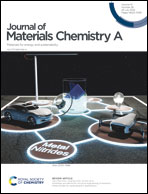Highly sensitive, weatherability strain and temperature sensors based on AgNPs@CNT composite polyvinyl hydrogel†
Abstract
Due to the application prospect in the wearable field, flexible conductive hydrogel sensors have attracted a lot of attention owing to their stretchability, sensitivity, self-repairing capacity and excellent compatibility. However, most conductive hydrogels basically suffer from problems such as inability to be used for single sensing and low responses. Here, we have prepared a highly responsive conductive hydrogel with weatherability, bifunctional sensing and antibacterial functions by adding silver nanoparticle (AgNP) modified carbon nanotubes (CNTs) to polyvinyl alcohol (PVA)/borax hydrogel (PBGA hydrogel). The PBGA hydrogel has been proven to have a good response range (up to 261%), linearity (0.989) and responsiveness (250 ms) for various deformations. The synergy of small and dense AgNPs and CNTs gives the hydrogel excellent responsiveness to temperature (TCR = −2.99% °C−1) and good linearity (0.998) over the −20 to 40 °C temperature range, capable of monitoring changes down to 0.1 °C and responsive to changes in water temperature. Based on the response of the PBGA hydrogel to different stimuli, a bifunctional bionanometer sensor has been developed that can detect changes in water temperature and changes in hydraulic pressure. This range of excellent sensing properties allows the PBGA hydrogel to show great potential in the field of wearable biosensors.



 Please wait while we load your content...
Please wait while we load your content...